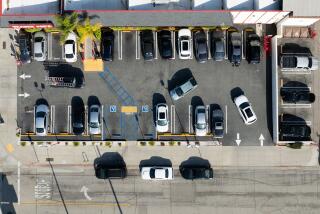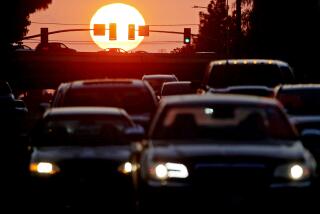The More Traffic, the Merrier--to a Point : Driving: Two researchers find that as the road becomes crowded, all vehicles start moving en masse at a steady speed, without passers to interrupt the flow.
- Share via
SAN FRANCISCO — Conventional wisdom says the more cars that crowd onto a given piece of pavement, the slower their journey and the more likely they’ll get to take part in an increasingly common cultural event--the traffic jam.
But the conventional wisdom is wrong--at least under certain circumstances. That’s what a pair of researchers say they discovered after feeding their computer buckets of data on how driver behavior affects traffic.
The report, published in Nature magazine, was written by Bernardo A. Huberman and Dirk Helbing.
Huberman, who works for Xerox in Palo Alto, says the basic premise can be stated in one sentence: At some point, the road becomes so crowded that easy passing is impossible--and the cars all begin moving at a steady speed, in a solid block of traffic.
The odds are they won’t be traveling at the speed limit--but they’ll be moving faster than if there were fewer cars and thus more options to pass and interrupt the flow of the pack.
“It’s really interesting to see,” he said. “Looking at simulations, we discovered that as you start increasing the number of cars on the road, you reach a special point where the whole mass of traffic moves as a solid block.
“When the density goes past that point, you once again see stop-and-go traffic.”
Another benefit, said Huberman, is a reduction in accidents. Traveling in such a block reduces changes in speed and passing opportunities, both of which contribute to highway carnage.
Is there a way to reach this asphalt nirvana?
In Europe, said Huberman, the Dutch are trying to create that solid state by lowering speed limits during rush hour. Reduced speeds also reduce the amount of space each car needs around it, thus allowing more cars to occupy each mile of pavement.
And then there are onramp traffic lights.
“The data say it’s possible to hold traffic at onramps to suppress traffic jam formation and in this way reduce average travel time,” Helbing said in a telephone interview from the University of Stuttgart in Germany, where he works.
Helbing said Germany is experimenting with using induction coils beneath the freeway to create a “smart” control of onramp traffic lights.
In the United States, those signals are on a regular timing schedule that doesn’t respond to ever-changing traffic patterns. But the German system, using information on the speed of traffic and the number of cars on the road, holds back traffic for a variable length of time to get as close as possible to creating that ideal block of traffic.
“The delay at the onramp is only a matter of minutes,” Helbing said. “While a traffic jam can easily double travel times, with that system, taking into account the time you’re waiting to merge, you’re still better off by about 20% or so.”
The California Department of Transportation, responsible for thousands of miles of overused pavement, already has onramp signals, but they aren’t very smart. However, CalTrans spokesman Jim Drago says there’s a more important issue.
“This whole question runs into a customer relations problem,” he said. “There you are, sitting at a light for a minute or two or three, watching traffic whizzing by. How do you deal with those complaints?”
Drago said that, on average, a maximum of 2,000 cars per lane pass a given spot every hour. Any more, and things start to slow.
But he’s not ready to reject the smart-light idea out of hand.
“Does that have an application? Sure. But it would require a real education program” to convince people that sitting at those onramp lights is good for them.
California took the concept one step beyond about two years ago, when it hosted the nation’s first test of an automated highway.
Tiny magnets embedded in the asphalt on either side of traffic lanes at four-foot intervals enabled cars with corresponding magnets to constantly orient themselves within the lane. The first working section of highway is expected to be open by September 2002, location unknown.
Cost of the technology? Less than $10,000 for a mile of freeway, compared to $1 million to $100 million for one mile of new highway, said Dick Bishop, spokesman for the U.S. Department of Transportation.
Of course, no matter how much technology you throw at the traffic-jam problem, there are always those drivers who just won’t cooperate.
“As long as you have people with the ability to make decisions,” he said, “the majority will be good, but you’re gonna have a few bad ones--and they create a mess.”
More to Read
Sign up for Essential California
The most important California stories and recommendations in your inbox every morning.
You may occasionally receive promotional content from the Los Angeles Times.










